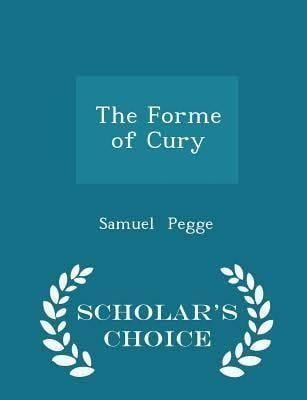Publication date c. 1390 Originally published 1390 Publisher Richard II of England Country England | Genre Cookbook Subject Cooking | |
 | ||
Author Similar Cookbooks, Other books | ||
The forme of cury the translation ep 1
The Forme of Cury (The Method of Cooking, cury being from Middle French cuire: to cook) is an extensive collection of medieval English recipes from the 14th century. Originally in the form of a scroll, its authors are listed as "the chief Master Cooks of King Richard II".
Contents
It is among the oldest English cookery books, and the first to mention olive oil, gourds, and spices such as mace and cloves.
Context
The scroll was written in late Middle English (c. 1390) on vellum and contains about 200 recipes (although the exact number of recipes varies slightly between different versions) with many of the same recipes as Ancient Cookery (Latin: Diuersa seruicia). The Forme of Cury may have been written partly to compete with Le Viandier of Taillevent, a French cookbook created around the same time. This supports the idea that banquets were a symbol of power and prestige for medieval lords and kings.
The name The Forme of Cury was given to the manuscript by Samuel Pegge, who published an edition of it in 1780 for the curator of the British Museum, Gustavus Brander. This name has since come into usage for almost all versions of the original manuscript even though they differ from each other. It is one of the best-known medieval guides to cooking.
Approach
In the preamble, the authors explain the recipes are meant to teach a cook how to make both common dishes as well as unusual or extravagant banquet dishes. They also note that the recipes were written with the advice of the best experts in medicine and philosophy.
Compared to another major book of medieval cuisine, Le Viandier, The Forme of Cury uses much more sugar; about 31% of the recipes use sugar (49% including fruit), compared to only 6% of recipes from the Viandier (8% including fruit).
The Forme of Cury is the first known English cookery book to mention certain ingredients such as cloves, olive oil, mace and gourds. Many recipes contain what were at the time rare and valuable spices, including nutmeg, caraway, ginger, pepper and cardamom. There are recipes for preparing many different types of animals, including whale, crane, curlew, heron, seal and porpoise. There are about 10 vegetable recipes, including one for a vinaigrette salad, which indicates influence from Portugal and Spain, as French cooks rarely used vegetables at that time. There are also several pasta dishes, evidence of Italian influence.
Some recipes in The Forme of Cury appear to be influenced by the Liber de Coquina, which had contributions from Arabic cuisine. For example, the recipe for mawmenee (see illustration) corresponds to the Arabic mamuniyya. The confectionery-like payn ragoun confirms the connection with Sicily (which had been Arab, Catalan and Norman), as it uses the Arab technique of cooking in soft ball syrup.
Sample recipe
The following is an example of a recipe taken from the modern critical edition of the text:
Sawse madame. Take sawge, persel, ysope and saueray, quinces and peeres, garlek and grapes, and fylle the gees þerwith; and sowe the hole þat no grece come out, and roost hem wel, and kepe the grece þat fallith þerof. Take galytyne and grece and do in a possynet. Whan the gees buth rosted ynouh, take hem of & smyte hem on pecys, and take þat þat is withinne and do it in a possynet and put þerinne wyne, if it be to thyk; do þerto powdour of galyngale, powdour douce, and salt and boyle the sawse, and dresse þe gees in disshes & lay þe sowe onoward.In modern English:
Sauce Madame. Take sage, parsley, hyssop and savory, quinces and pears, garlic and grapes, and stuff the geese therewith, and sew the hole that no grease come out, and roast them well, and keep the dripping that falleth thereof. Take meat jelly and dripping and add in a posset; when the geese be roasted enough; take and smite [cut] them into pieces, and that that is within, and add in a posset and put therein wine if it be too thick. Add thereto powder of galangal, powder-douce and salt and boil the sauce and dress the Geese in dishes and lay the sauce onward.Modern recreations
The Café at the Rylands, in Manchester's John Rylands Library, cooked Tart in Ymber Day, Compast, Payn Puff, Frumenty and Gingerbrede, accompanied by Piment (spiced wine), for invited guests in 2009.
